Collection: St. Francis, Le Fou de Dieu
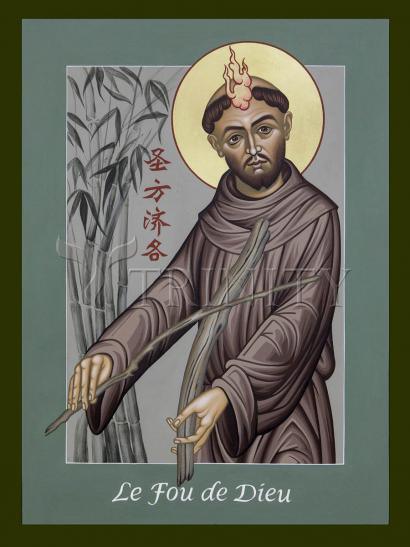
-
Sale
Wood Plaque Premium
Regular price From $99.95 USDRegular priceUnit price per$111.06 USDSale price From $99.95 USDSale -
Sale
Wood Plaque
Regular price From $34.95 USDRegular priceUnit price per$38.83 USDSale price From $34.95 USDSale -
Sale
Wall Frame Espresso
Regular price From $109.95 USDRegular priceUnit price per$122.17 USDSale price From $109.95 USDSale -
Sale
Wall Frame Gold
Regular price From $109.95 USDRegular priceUnit price per$122.17 USDSale price From $109.95 USDSale -
Sale
Wall Frame Black
Regular price From $109.95 USDRegular priceUnit price per$122.17 USDSale price From $109.95 USDSale -
Sale
Canvas Print
Regular price From $84.95 USDRegular priceUnit price per$94.39 USDSale price From $84.95 USDSale -
Sale
Metal Print
Regular price From $94.95 USDRegular priceUnit price per$105.50 USDSale price From $94.95 USDSale -
Sale
Acrylic Print
Regular price From $94.95 USDRegular priceUnit price per$105.50 USDSale price From $94.95 USDSale -
Sale
Giclée Print
Regular price From $19.95 USDRegular priceUnit price per$22.17 USDSale price From $19.95 USDSale -
Custom Text Note Card
Regular price From $300.00 USDRegular priceUnit price per$333.33 USDSale price From $300.00 USDSale
ARTIST: Fr. Michael Reyes, OFM
ARTWORK NARRATIVE:
"What else are the servants of God but God's minstrels, whose work is to lift up people's heart to spiritual joy, that they might love God gladly."
—St Francis of Assisi
His feast day is October 4.
- Art Collection:
-
Saints & Angels
- Patronage:
-
Zoos,
-
Peace,
-
Needle Workers,
-
Merchants,
-
Laundry Workers,
-
Lace Workers,
-
Fire,
-
Families,
-
Environmentalists,
-
Environment,
-
Embroiderers,
-
Ecology,
-
Ecologists,
-
Dying Alone,
-
Diocese of Salina KS,
-
Colorado,
-
Catholic Action,
-
Birds,
-
Assisi Italy,
-
Archdiocese of Santa Fe NM,
-
Archdiocese of San Francisco CA,
-
Archdiocese of Denver CO,
-
Animals
- Lentz collection:
-
Saints, Martyrs and Holy People,
-
Franciscan Images
The Life of St. Francis of Assisi
The founder of the Order of Friars Minor known as the Franciscans, St. Francis was born at Assisi in Umbria in 1181 A.D. His mother named him Giovanni after St. John the Baptist. However, his father, Pietro Bernadone, a cloth merchant, who was away during the child's birth renamed him Francesco (the equivalent of calling him a Frenchman) as he did not want a son to be a man of God but rather a merchant who shared his passion for France.
Francis lived a rather carefree and rich existence. He was always happy and charming and everyone loved him. He was a born leader. Francis developed his father's love of France and desired to be a knight. He got his chance to gain the prestige that he desired when Assisi declared war on its longtime enemy, Perugia. Many of his comrades were killed but due to the social stature of Francis, he was instead taken prisoner and held for ransom. Ransomed by his father, he returned home and was seriously ill for over a year. Francis again had a chance for glory during the Fourth Crusade; however, upon leaving Assisi he had a dream in which God told him to turn back which he did.
Francis spent the next 25 years spending more time in prayer and weeping for his sins. He also continued on with his business.
The Ministry of St. Francis
While praying at the Church of San Damiano, he heard Christ speak to him saying, “Francis, repair my church." In order to fulfill this request, he sold some of his father's goods. This angered his father greatly and he took Francis to see the local bishop. Francis threw off his rich clothes in the presence of the bishop and revealed that he was wearing a shirt made of hair. The bishop, upon seeing this, covered him with his own cloak as a sign of accepting him into the religious life. After this, his father disowned and disinherited Francis.
Francis then went back to San Damiano and rebuilt the church with his own hands. He did not realize that God did not mean the church at San Damiano to be rebuilt but rather the universal church that was suffering from inside scandal and avarice as well as outside heresies.
Soon after, Francis started to preach about a return to God and strict obedience to the Church. Francis had many followers who assisted him in his mission. Francis told them that their rule was to follow take up the cross daily and to renounce all material possessions. He and his companions followed the Gospel literally and went out to preach in twos. Not only did Francis's companions come from all walks of life, but also from nature itself. He felt that all of God's creations were part of his brotherhood.
One famous story tells of Francis preaching to hundreds of birds about being thankful to God for their independence and His care. According to the story the birds remained still and only flew away when Francis allowed them to leave.
Francis continued to live with and for the poor. Wishing to found a new order, the Brotherhood of Poverty, he went to Rome in 1210 when Pope Innocent III gave him the permission to do so.
During the Fifth Crusade, Francis traveled to Syria in an attempt to convert the Muslims. During battle, in an attempt to make peace, Francis went directly to the Sultan. The Sultan was so charmed by Francis that he did not kill Francis and his companions and even stated that he would convert to Francis's religion if not for fear that they would both be murdered for it.
St. Francis and the Wolf of Gubbio
Another story which acknowledges Francis' reputation for holiness and peace tells of his encounter with the Wolf of Gubbio. This story in depicted in our church in the mural above the altar. The story tells that the people of the small town of Gubbio made known to Francis that there was a ferocious wolf in their area. All of their efforts to trap the wolf or to drive it away had been unsuccessful so they called upon Francis to intervene on their behalf. Armed only with the message of the Gospel, Francis went out to meet the wolf and called him to repentance for the harm that he had caused throughout the countryside. After this, the wolf and the townspeople agreed to live in peace. The wolf would no longer attack the townspeople and in return the townspeople would provide food for the wolf.
It is believed that such legends have a basis in historical fact. Many historians and scholars have believed that this popular tale of Francis exercising spiritual power over the world of animals has at its center a factual basis but no less importance spiritually. It is entirely possible that the “Wolf of Gubbio" signifies a name attached to an outlaw of the time that raided and robbed the small village. When confronted by the townspeople, the outlaw would always prevail. Francis, challenged the robber in the name of the Lord to reconcile with the people of Gubbio and to experience the peace that only Christ can bring. Thus the legend points to a more enduring dimension of Francis' historical ministry, the reconciliation of sinners and their reintroduction into mainstream life through forgiveness.
St. Francis and St. Clare
During the Lent of 1212, a new joy, great as it was unexpected, came to Francis. Clare, a young woman living in Assisi became moved by Francis' preaching at the Church of St. George. Clare sought him out, and begged to be allowed to embrace the new manner of life he had founded.
Francis agreed and Clare, who was only eighteen, left her father's house in secret on the night following Palm Sunday, and with two companions went to the Porziuncola, where the friars met her in procession, carrying lighted torches. Francis then cut of her hair and clothed her in the Minorite habit and thus received her to a life of poverty, penance, and seclusion.
Clare stayed provisionally with some Benedictine nuns near Assisi, until Francis could provide a suitable retreat for her. Also with her were her sister St. Agnes and other pious maidens from the area. He eventually established them at St. Damian's, near to the chapel which he had rebuilt with his own hands, and was now given to the saint by the Benedictines as domicile for his spiritual daughters. This became the first monastery of the Second Franciscan Order of Poor Ladies, now known as the Poor Clares.
A shrine, pictured above, to St. Francis and St. Clare can be scene in our present day church to the right of the altar in the location of the former confessionals.
The Last Years of St. Francis
Francis' final years were filled with suffering. While praying to share in the passion of Christ, Francis had a vision and received the stigmata, the wounds of Christ on the cross.
Additionally, years of poverty and traveling had made Francis ill. He began to go blind and the pope ordered that his eyes be operated on which meant cauterizing the face with hot irons. Francis claims to have felt nothing at all when this was done. Even after the operation, Francis remained positive and wrote the Canticle of the Sun which expressed his brotherhood with creation in praising God.
France died on October 4, 1226 at the age of 45. He was canonized in 1228, an unusually shortly period after his death for such an event to take place. He is usually depicted in a brown Franciscan habit surrounded by animals and flowers. He is considered to be the founder of the Franciscan Order and is also the patron saint of merchants and ecologists
Additional Items Our Customers Like
-
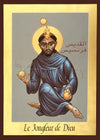
St. Francis, Jongleur de Dieu (by Br. Robert Lentz, OFM)
-
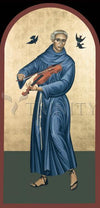
St. Francis Solano (by Br. Robert Lentz, OFM)
-
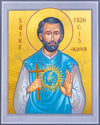
St. Francis Xavier (by Robert Gerwing)
-
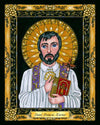
St. Francis Xavier (by Brenda Nippert)
-
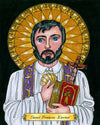
St. Francis Xavier (by Brenda Nippert)
-

St. Francis Xavier Presenting to Christ People He Converted (by Museum Religious Art Classics)


















